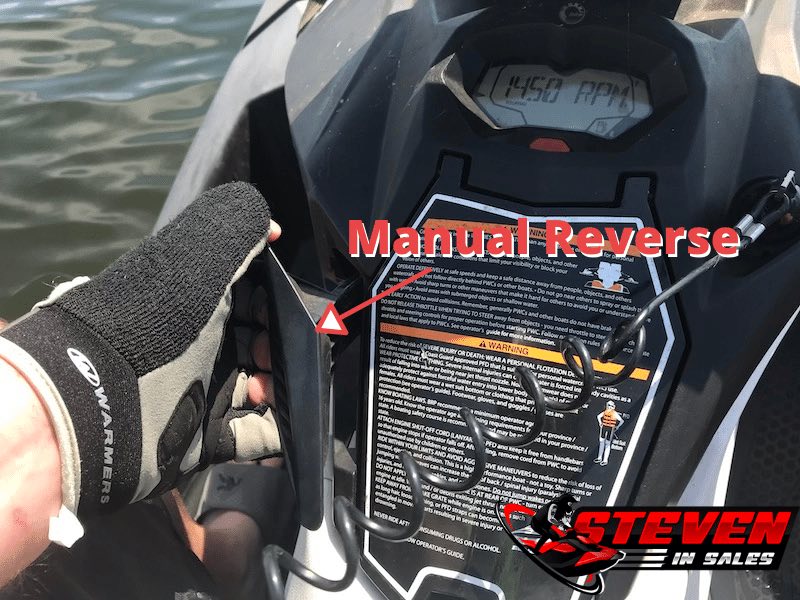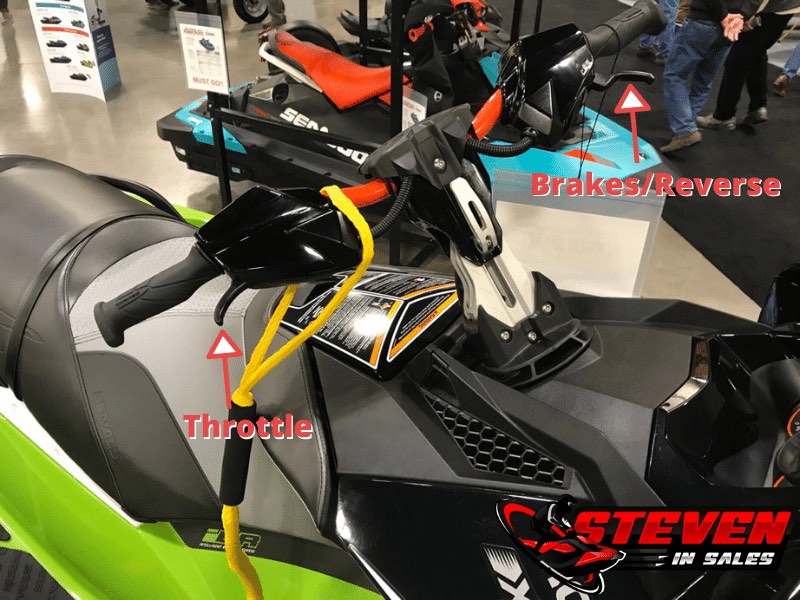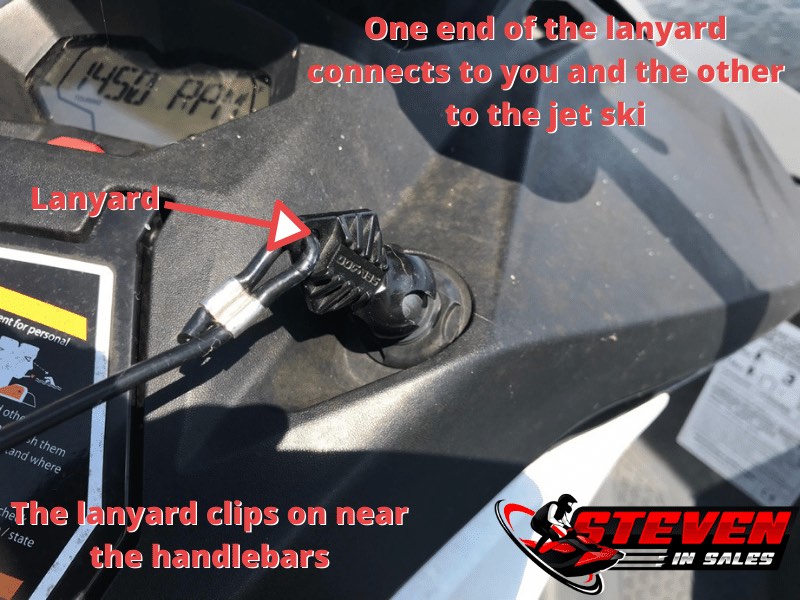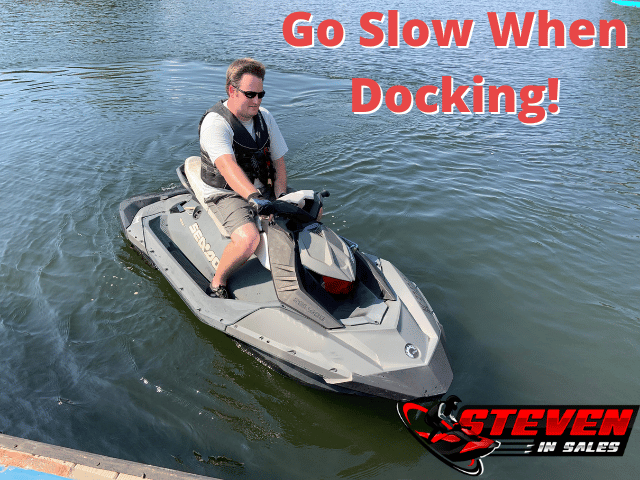Feel the rush of the wind against your face, the spray of the waves beneath you, and the exhilarating freedom of tearing through the water on a PWC.
In this post, we’re diving into the thrilling world of PWCs and why it’s an experience like no other.
Whether you’re a seasoned rider or a newbie eager to feel the adrenaline, get ready to explore why PWCs isn’t just a hobby — it’s an adventure waiting to happen!
What Are Jet skis?
If you’re new to PWCs, you might want to know what they are and the way they work.
A PWC is a small boat, often called the motorcycle of the water. They hold 1 to 4 people who sit in a line front to back. You have a handlebar that controls steering, throttle and some models have reverse and braking system.
A jet ski uses a jet drive to propel it through the water. While it’s similar to a boats’ propeller, it’s very different when opearting in the water. You’ll find you have far greater control at the dock compared to other boats, but there are quirks like needing to give the jet ski throttle to steer when slowing down.
The Types Of Watercraft
Not every watercraft is the same and each one will operate differently.
You have stand up and sit-down models, with sit-down being the most common. The most common seating capacity of a sit-down watercraft is 3 people, but it’s common for people to think they’re a 2-seater because the seats are small.
With sit-down watercraft, you have models that are basic, to models made for fishing with a live-well and fish finder. You also have slow jet skis and racing ones that have over 300HP, I don’t suggest these for new riders. Some models are more stable than others, and some are more playful.
Not every PWC will have reverse or brakes, but it’s becoming more common every year. I go over the controls for a PWC with reverse, brakes, and the ones that lack both. If a jet ski has brakes, it will have reverse, as they’re just about the same.
This post will be geared more towards sit-down jet skis, as they’re the most common. For the current year, there are over 50 different models of PWCs on the market, and only 2 of them are stand-ups, and it’s been that way for years. So standups are not something I’ll be touching in this post.
Before You Hop On
Before you take off or touch the water, there are a few things you need to first!
- Make sure the drain plugs are in.
- Start it for 5 seconds to make sure it starts fine.
- Remove rear trailer straps.
- Make sure you have your life jacket on.
- Only start in 3ft or more of water.
- Ensure the lanyard is connected to you and the watercraft before driving.
Handlebars are used to control the steering.
On the handlebar, you’ll find the buttons and triggers that control it.
Some come with manual reverse; as shown below, you pull a lever to drop the reverse bucket.

The Sea-Doo lanyard is the “key” and “kill switch” in one that starts your engine. One end goes on the Sea-Doo, the other your life jacket.
Kawasaki and Yamaha lanyard clips on the left side of the handlebars and acts only as the kill switch.
Transmission
There are 3 types of “transmission” modes.
- Forward only
- Forward, neutral, and reverse
- Forward, neutral, reverse, and brakes
Not all of them have brakes or even reverse.
If it does have reverse, it can either be manual or electronic.
Attach The Lanyard To Yourself
The lanyard will need to be attached to you; with Sea-Doo, it has a clip to connect to your life jacket.
For Yamaha or Kawasaki, they give you a wrist strap.
The lanyard needs to be on you and connected to the lanyard spot! What happens if the lanyard is not connected? The engine won’t run if the lanyard is not connected properly! The lanyard is a safety switch that will shut the engine off if you fall off.
Turning The Engine On
Before you start your engine, you need to be in at least 3 feet of water.
Every manufacturer is different, so please consult your owner’s manual for exact details for starting the engine.
Starting Steps
- Press the start/stop button to wake the display up.
- Place the lanyard onto the correct spot, with the other end attached to you.
- Make sure the gauges have no errors before starting.
- Hold the start/stop button until the engine has fully started. (Must hold the button down until the engine has fully started!)
To shut the engine off, either hold down the start/stop button or pull the lanyard off.
They Move As Soon As You Start Them
Make sure you’re clear around your machine before you start it, as it will most likely move, even if slightly.
- If yours has brakes, then it will start in neutral.
- If you don’t have brakes, you will start in whatever position you’re in, which is often the forward position.
Even if you have brakes, be prepared to move.
Keep The Handlebars Straight When Turning The Engine On!
A direct-drive system is used on every PWC, so they will move in the direction of the handlebars even when starting the engine.
For example, if you start the engine with the handlebars turned right, it will slowly turn right. This is for models with brakes, as they start in neutral.
Models without brakes will begin moving at idle speed in the last direction you left them (forward or reverse) when you start the engine, so be prepared to move.
Docking
The trick to docking is to go slow.
If You Have Brakes
The trick is to spend more time in “neutral” than you do in forward when around the docks or trailers.
I only use forward or reverse if I need a boost or go in a different direction.
Manual Reverse
The reverse lever is only moving a bucket in the rear, which redirects the flow of water.
Between forward and reverse is neutral, so all you got to do is find that “sweet spot” for neutral.
Once you find that sweet spot, stay around it to help you go slow; just like the instructions for the braking models, you want to spend most of your time in neutral around the docks and little time in forward or reverse and only use them when needing a boost or a change of direction. (You want to go slow, painfully slow, trust me!)
Forward Only
You have the trickiest one of them all.
A neat trick you can do to kill your momentum is to spend in a circle at idle.
One spin in your spot at idle will kill any momentum you have, and you can point to where you need to go and then kill the engine.
Just make sure you’re aware of your size and what is around you before you spin.
Once you’re at the dock, shut It Off
As discussed earlier, PWCs are direct-drive, so if the engine is on, the impeller is spinning.
Never leave them running, even if it’s in neutral when docked!
Do You Need To Give It Gas To Steer?
If you’re coming to a stop and try to turn the handlebars, you’ll notice it won’t steer.
You need to give them some gas to steer.
Assisted Throttle
You’ll notice that some manufacturers will even bump the RPMs to give you steering in this type of situation.
Unfortunately, not every ski has this feature, so it’s better to do it yourself.
Idle
The Sea-Doo will steer if you’ve been at idle speed, but it needs some gas when not idling around. For example, slowing down, you will have to give it throttle to steer. Also, a Sea-Doo will not steer if the engine is off.
No-Wake Areas
No-Wake areas are the “school zone” of the water.
You go slow and watch out for people.
200 Feet From Land
In many states, a No-Wake zone is 200 feet from land. (Some is only 100 ft) A white buoy is also used to let boaters know you’re in a No-Wake zone.
In a No-Wake zone, you go at idle speed.
Do Boaters Hate Us?
Many boaters dislike jet skis, and some find their idle speed too high.
It’s common for other boaters to mistake your idle speed for too high in no-wake zones.
Stay within 5 mph in no-wake zones (no throttle), follow the rules, and be considerate of other boaters to avoid conflicts.
Slow-Speed Modes
Some models have a “No-Wake Mode” or a “Slow-Speed mode” that allows you to set the speed from 1 mph to 5 mph.
This mode often comes packaged with models that also have “cruise control” or a “speed regulator/limiter”.
Remember, Wind Affects You
Operating a PWC is different from driving a car because wind and waves can alter your course.
Be aware that wind and current can be helpful or challenging when docking, especially on windy days.
Driving A PWC Is A Little Different From A Boat
If you can manage a boat, a PWC will not be hard.
But there are a few things to keep in mind.
- It’s a direct-drive system, so if the engine is on, the impeller is spinning. This means it can spin on its self while in neutral.
- PWCs are also smaller and lighter, so you must take it easier when around the docks.
- Also, backing up is the opposite of what you think with a jetdrive compared to other boats.
Practice!
The best advice I can give you is to practice.
Find a quiet spot on the water to test your controls and maneuvering skills. Then, see how it responds and test different situations out.
If it has brakes, try them out to see how long it takes to slow down.
To practice docking, get an inflatable tube and a quiet spot and try getting close to it without touching it. Try coming at it from the front and both sides. The tube works great as there is no pressure and if you do hit it, then it’s no big deal as it bounces away.
With enough practice, you’ll be an expert in no time.




A couple of other requirements:
You need to have a fire extinguisher onboard. Most PWCs have a bracket to hold your fire extinguisher.
In coastal waters and on the Great Lakes you need a Coast Guard approved visual distress signal, such as an orange distress flag. Some states like Ohio require a distress flag on any lake.
Have fun! As noted, a dry box is a great idea not only for your phone but also your car key fob and wallet.